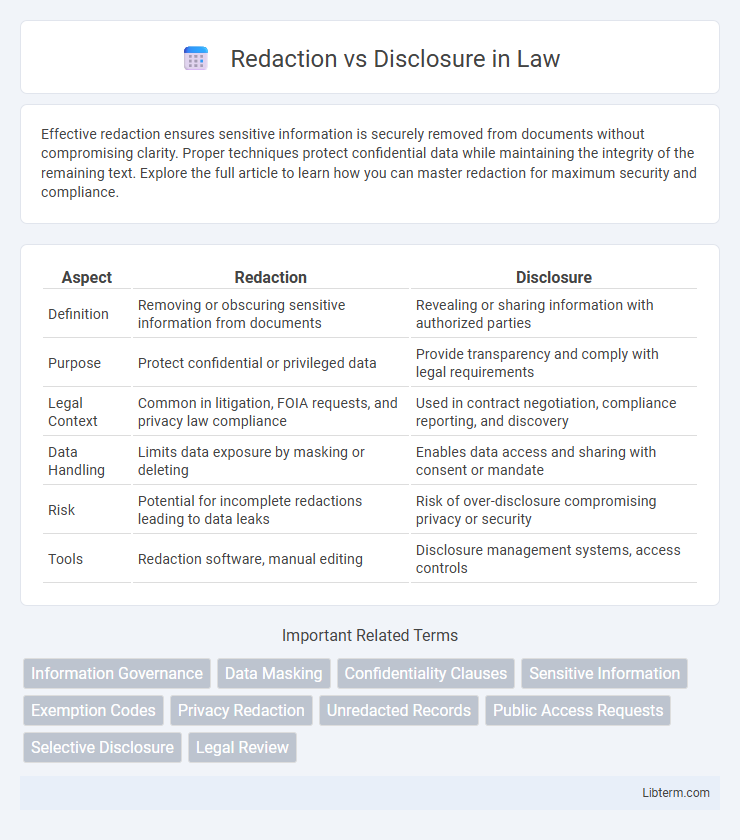Effective redaction ensures sensitive information is securely removed from documents without compromising clarity. Proper techniques protect confidential data while maintaining the integrity of the remaining text. Explore the full article to learn how you can master redaction for maximum security and compliance.
Table of Comparison
| Aspect | Redaction | Disclosure |
|---|---|---|
| Definition | Removing or obscuring sensitive information from documents | Revealing or sharing information with authorized parties |
| Purpose | Protect confidential or privileged data | Provide transparency and comply with legal requirements |
| Legal Context | Common in litigation, FOIA requests, and privacy law compliance | Used in contract negotiation, compliance reporting, and discovery |
| Data Handling | Limits data exposure by masking or deleting | Enables data access and sharing with consent or mandate |
| Risk | Potential for incomplete redactions leading to data leaks | Risk of over-disclosure compromising privacy or security |
| Tools | Redaction software, manual editing | Disclosure management systems, access controls |
Introduction to Redaction and Disclosure
Redaction involves the deliberate removal or obscuring of sensitive information within documents to protect privacy or confidentiality, commonly used in legal, governmental, and corporate contexts. Disclosure refers to the act of releasing or sharing information, often mandated by laws or policies to ensure transparency, compliance, or informed decision-making. Both processes are critical in managing information sensitivity while balancing the need for public access and data protection.
Defining Redaction
Redaction involves the deliberate removal or obscuring of sensitive information within a document to protect privacy and confidentiality before its release. This process ensures that classified or personal data is concealed, preventing unauthorized access while maintaining the overall context. Redaction is critical in legal, governmental, and corporate settings to comply with privacy laws and regulatory requirements.
Defining Disclosure
Disclosure refers to the process of making information accessible or available to authorized parties, often involving the release of documents or data during legal proceedings, compliance audits, or corporate reporting. It ensures transparency by revealing relevant facts while maintaining confidentiality where necessary. Proper disclosure balances the need for openness with the protection of sensitive or privileged information.
Key Differences Between Redaction and Disclosure
Redaction involves permanently removing or obscuring sensitive information from documents to protect confidentiality, while disclosure refers to the act of making information available or accessible, often for legal or regulatory compliance. Key differences include the purpose where redaction aims to prevent data exposure, whereas disclosure is intended to share relevant information. Redaction modifies the original content for privacy, whereas disclosure preserves the integrity of the information by releasing it in its entirety or selectively.
Legal Implications of Redaction
Redaction involves the deliberate removal or obscuring of sensitive information within documents to protect confidential or privileged content, minimizing legal risks related to unauthorized disclosure. Failure to properly redact can result in violations of privacy laws, breach of attorney-client privilege, or exposure to litigation, emphasizing the importance of meticulous redaction processes in compliance with legal standards. Courts often scrutinize redaction to ensure no relevant or non-exempt information is improperly withheld, making accuracy and transparency crucial in legal document handling.
Legal Implications of Disclosure
Disclosure involves revealing information that may be protected by law, triggering legal obligations and potential liabilities for unauthorized sharing. Redaction serves as a critical tool to comply with privacy laws, such as GDPR or HIPAA, by obscuring sensitive data before documents are released. Failure to properly redact can result in legal sanctions, including fines and litigation, for breaching confidentiality and data protection regulations.
Common Use Cases: Redaction vs Disclosure
Redaction is commonly used in legal, healthcare, and government documents to protect sensitive information such as personal identifiers, classified data, or proprietary secrets before public release. Disclosure involves the deliberate release of information to authorized parties for transparency, compliance, or collaboration, often seen in financial reporting, regulatory filings, and corporate communications. Balancing redaction and disclosure ensures sensitive data remains confidential while meeting legal and ethical obligations for transparency.
Best Practices for Redaction and Disclosure
Effective redaction ensures sensitive information is permanently removed from documents using reliable software that prevents data recovery, adhering to legal standards such as HIPAA or GDPR. Disclosure best practices involve thoroughly assessing document content for relevance and confidentiality, applying the minimum necessary information principle to protect privacy while maintaining transparency. Maintaining audit trails and regularly training staff on compliance protocols strengthens the integrity of both redaction and disclosure processes.
Risks and Challenges Involved
Redaction involves removing sensitive information from documents to protect confidentiality, while disclosure entails sharing information that may include sensitive data under regulatory or legal obligations. Risks associated with redaction include incomplete removal leading to data leaks or legal penalties, whereas disclosure poses challenges like ensuring compliance with privacy laws such as GDPR or HIPAA and preventing unintended dissemination. Both processes demand meticulous accuracy and robust security measures to mitigate risks of data breaches and reputational damage.
Conclusion: Choosing the Right Approach
Choosing the right approach between redaction and disclosure depends on the sensitivity of the information and the intended audience. Redaction ensures confidential data is securely withheld to comply with privacy regulations, while disclosure promotes transparency and facilitates informed decision-making. Organizations must balance legal requirements, ethical considerations, and operational goals to determine the optimal strategy for managing sensitive content.
Redaction Infographic

 libterm.com
libterm.com